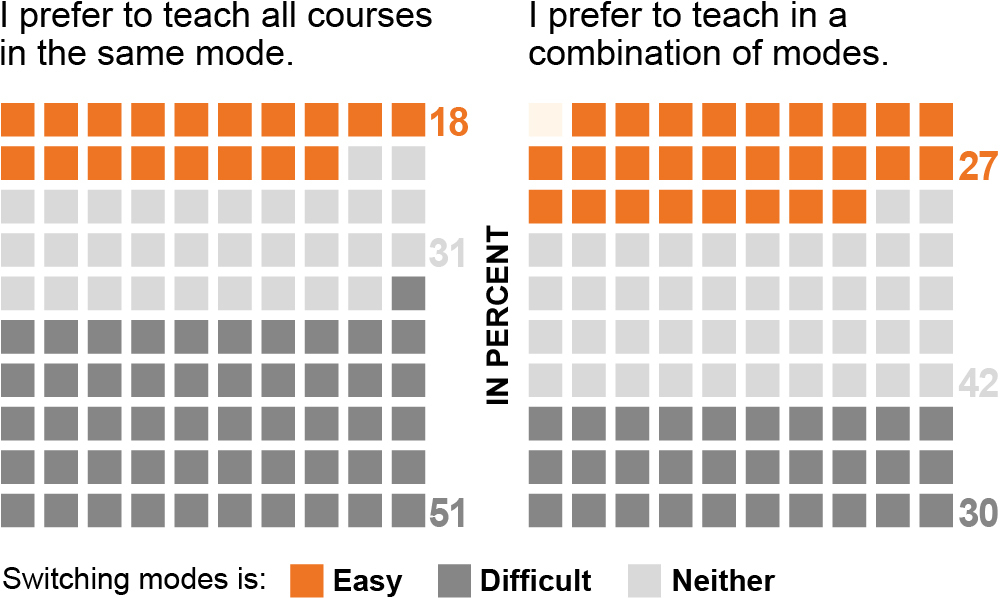You have /5 articles left.
Sign up for a free account or log in.

The debate and preference over remote versus in-person learning continues.
Faculty preference for in-person teaching has eroded considerably in the years since the start of the COVID-19 pandemic and the explosive growth in remote learning, a new survey finds.
Educause’s “Faculty and Technology” report found that 53 percent of faculty prefer teaching courses in person. In the 2019 survey, 73 percent of faculty surveyed said they preferred teaching mostly or completely on-site.
The survey of 982 faculty, conducted in spring 2023, is the first since 2019 for Educause, a nonprofit focused on higher education and the industry’s intersection with information technology.
The report defines “in-person” as classes that are held on campus in a classroom, while online classes are held in spaces remotely outside a classroom.
Despite the decline in the preference for in-person teaching, nearly 90 percent of faculty in 2023 said they believed in-person delivery leads to better engagement—and therefore better academic output and performance.
“Even though we show clear differences in teaching modality preferences, the bigger story that emerged, I think, is that no single modality is clearly ‘best,’ and faculty are certainly willing to teach in non-preferred modes,” said Nicole Muscanell, a researcher at Educause, in an email to Inside Higher Ed. “Our findings show that the reasoning behind modality preferences is very nuanced.”
About 70 percent of faculty taught a remote class during the pandemic, and the preference for remote teaching has grown, according to the report. Of those surveyed, 20 percent said they prefer to teach hybrid courses that mix in-person and online instruction, while 18 percent prefer teaching fully online courses. That is a big bump from the 2019 survey, in which just 9 percent of respondents preferred teaching completely online.
What are the reasons for the modality preference?

The reasons for modality preferences, according to a 2023 Educause survey.
Justin Morrison/Inside Higher Ed | 2023 Faculty and Technology Report/EDUCAUSE
More Faculty Time With Tech
Faculty are not against using technology in the classroom, but they do want time to prepare. More than 90 percent of those surveyed ranked adequate prep time as very important. Design support, or helping faculty with designing effective student assessments, was the second-highest-ranked instructional support faculty wanted, with 68 percent calling it important.
However, while resources are often offered to faculty members, according to the report, there is not always time to use them. Roughly 70 percent said they used provided resources meant to help with instruction “sometimes,” with 15 percent saying they do not use them at all and the remaining 15 percent using them often.
Faculty wanting more time does not mean they are uneasy in their use of technology. According to the report, 96 percent of faculty surveyed feel competent or advanced in their technological skills. Only 4 percent classified themselves as “beginner” level.
Faculty cited flexibility as the top reason they preferred hybrid learning. However, equity, access and health and safety also played a role, according to the report.
How faculty prefer to teach

A graph of how faculty prefer to teach according to an Educase 2023 survey.
Justin Morrison/Inside Higher Ed | 2023 Faculty and Technology Report/EDUCAUSE
When classes are remote or hybrid, faculty said they prefer choosing the modality and having students all use the same mode of learning, whether it be entirely in person or entirely remote.
“It’s hard to say whether modality preferences will continue to change, and to what extent,” Muscanell said. “If faculty are provided with adequate time, instructional support and resources, and opportunities to gain more experience teaching online and hybrid courses, we could see preferences for those modalities increase.”
Despite that slight majority preferring in-person teaching, nearly all faculty prefer to make at least some class resources available online. Presentation slides, homework assignments and required readings were all course components that more than 80 percent of faculty preferred to offer digitally.
Which of the following course components faculty prefer to make online

A list of the course components professors prefer to list online, regardless of course delivery.
Justin Morrison/Inside Higher Ed | 2023 Faculty and Technology Report/EDUCAUSE
Recommendations on How to Support Faculty
Educause also asked faculty members what their institutions could do to better support their teaching across various modalities. The report summarized the responses with a set of recommendations on how to support teaching:
- Provide more time, specifically for course design and development
- Provide—and give advance notice of—opportunities for training and professional development
- Collect and share examples of effective teaching and course design
- Set clear expectations for students in each modality and give clear terminology for each instructional modality
Additional recommendations included providing more technology, staff support and incentives for course development plus giving faculty more choice in whether they teach in person, online or hybrid.





